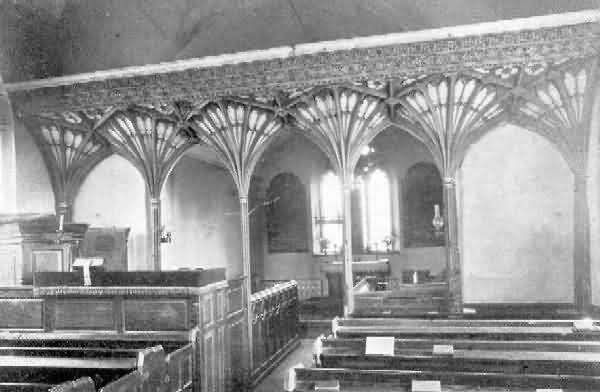
«SOME OLD DEVON CHURCHES» BY JOHN STABB; 61-72
Clyst St. Lawrence [61]; Cockington [62]; Coffinswell [63]; Cofton [64]; Colebrook [65]; Coleridge or Coldridge [66]; Colyton [67]; Combe-in-Teignhead [68]; Combe Martin [69]; Cookbury [70]; Cornworthy [71]; Cotleigh [72].
CLYST ST. LAWRENCE. St. Lawrence. The church consists of chancel, nave, south porch, and west tower. There is a screen of five bays across the chancel [plate 61], retaining its ancient colouring and gilding, but the tracery has all been removed from the bays and the ancient cresting has been replaced by a plain wooden one; at one time it must have been an exceedingly fine screen.
There is a gallery in the tower arch, and on each side of the arch are carved grotesque heads. The arms of Charles II [r. 1660-1685] are preserved beneath the gallery.
In the chancel is buried the Rev. Charles E. Walkley, who was rector of the parish for the long period of 61 years; he died September 4th 1865, at the age of 85 years. There are some carved bosses in the roof, but they have been whitewashed over, as has also the font, which is of plain design.
Over the chancel arch is hung an interesting painting. It represents a triangle cut off at the three corners by three circles, symbolising the three Divine Persons, with an inscription showing the difference and the equality of the three hypostaces, the difference is on the side of the triangle, and the equality converges towards the centre, meeting in another circle. This triangle is sometimes depicted as supported by a figure with three faces, but in this instance there is no figure; with the figure, it is said by Hone (Ancient Mysteries Described, p. 86) to have been the arms of Trinity Priory, Ipswich [Suffolk]; and in Didron's Christian Iconography, in a footnote, it is stated that this design was commonly seen after the commencement of the 15th century. It may be found sculptured on a house in Bordeaux, said to have been inhabited by Montaigne [1533-1592], and in the counties of Norfolk, Suffolk, and Essex it is constantly to be met with. The note also says:— "We are assured that they occur in the eastern part of England alone and have never been seen in the north or the west." If this statement is correct, and this is the only place in Devonshire in which I have seen this design, the representation in this church is of great interest.
The old cross remains in the church, but the top is rather worn. In the north-east corner of the tower there is a statue of the Blessed Virgin and Child, and the building has some very grotesque gargoyles.
The registers date: baptisms, 1539; marriages, 1540; burials, 1541.
COCKINGTON. St. George and St. Mary. [Originally a chapel of Mediæval origin], the church was appropriated to the Abbot and Monastery of Torre in 1203, Abbot Richard being responsible. The [present] church is Perpendicular, and it is said to have been erected in 1348. It consists of chancel, nave, north and south aisles, and embattled west tower with clock and three bells.
There is a rood screen to nave and aisles, of good detail, but much mutilated [plate 62a]. The groining is gone, and the spandrels painted with figures of angels and a small diaper-pattern of gold and vermilion. The lower portion has been covered with old seat ends with linen-pattern panels.
In the chancel are fine stalls with misericords of 15th century date. The pulpit [plate 62b] was brought from Torre Parish Church about 1820 by the Rev. Roger Mallock, the then Squire of Cockington, who saved it from being broken up, and purchased it for the church. It is composed of various pieces of screen work, some 15th century, some which looks like early 16th century, and as being parts of a rood gallery front. A book-rest of still later date is attached to it; the cutting of the uprights or mullions is very interesting in detail, 16th century work.
There is some ancient glass in one of the windows on the south side of the church. One of the figures represents a pilgrim in full pilgrim's dress: hat, cloak, scrip, book of hours, and staff with crook for carrying water bottle. It is supposed to represent Robert Cary, who went on pilgrimage to [Santiago de] Compostela [Spain].
The font [plate 62c], of Caen stone, is octagonal in shape, and dates from before 1540. It bears a mutilated inscription on brass in Old English letters:— Robert Cary Armigeri E— The following "t" of Et is missing. He died June 15th 1540, and is buried in Clovelly Church. The date on the font is March 2nd, but the date of the year is broken and lost. It is possible that the font was the offering of William Cary, who was Lord of the Manor of Cockington, as well as possessed of large property in North Devon. The panels on the font show the alliances of the Cary family: Cary, Carew, Dinham, and Paulet. The handsome cover is not the original one, this may have been destroyed by the iconoclasts who destroyed the rood loft. The present cover, of Elizabethan or Jacobean date, was found by the present vicar in pieces and much decayed, the top being lost. It was restored carefully and decay arrested. The carving is of the Elizabethan domestic pattern type, and the material is pine wood. The top is modern, but is copied from an old font cover at Bramford in Suffolk. The original hinges are preserved. The work of restoration was carried out by Harry Hems, of Exeter, about 8 years since [ca. 1901], for the present vicar, the Rev. J. Henning.
The registers date: baptisms, 1628; marriages, 1632; burials, 1632.
COFFINSWELL. St. Bartholomew. The church consists of chancel and nave, without division (the waggon roof extending from the east end to the west), north aisle divided from the nave by four arches supported on columns with carved capitals, small south transept, north porch, and west tower with six bells; two of these are pre-Reformation bells and bear in Old English lettering the inscription:— Protege Virgo Pia quos Sancta Maria; two date from 1626 and 1637, and have the inscription:— Soli Deo detur gloria; the latter was recast in 1894, when a fifth bell was added with the inscription:— Sit Deo gloria; the sixth bell was added in 1904.
There is a piscina in the south wall of the chancel, and a tablet to the memory of Thomas Patch and his wife Johanna, and their two sons, dated from 1706 to 1724. On the capital of the western pillar are four coats of arms of the Scobahull, Holbeme, Leyton, and Gambon families. The font [plate 63] is old with a circular bowl with a narrow border of carving round the top, and the rest of the bowl completely covered with carving, beneath the bowl there is cable moulding, the plain shaft rests on a square base. Over the porch is the inscription:—
Thomas Street
Churchwarden
1729
W.T. 1768
In the vestry are preserved the old stocks, remarkable for the fact that the board with the holes for the feet is flat instead of upright, so that the prisoners would either have to stand in them, or sit in a very cramped position. The old parish chest is also kept here, and some pieces of lead with foot and hand marks on them. I believe at one time visitors to the roof used to amuse themselves by tracing the shape of their hands and feet on the lead covering, and when the rood was re-leaded these shapes were preserved.
The registers date: baptisms, 1560; marriages, 1560; burials, 1561.
COFTON. St. Mary. The church consists of chancel with piscina, a modern stone altar and reredos, nave, north aisle, and south porch.
The west window, filled with glass representing the Ascension, is in memory of the Rev. John Nicholas Lightfoot, who died February 12th 1884; he was 26 years pastor and first vicar of this church. A tablet on the outside of the church beneath the west window has the following inscription:— This chapel which was founded in the 14th century, having remained in a ruinous state for more than 70 years was restored by William Courtenay, Earl of Devon, and reopened for Divine Service January 9th 1839. Charles Fowler Esq. Architect
Jonathan Parsons, Clerk of Works. The north aisle was restored by public subscription in 1863.
The registers date from 1864.
COLEBROOK. St. Andrew. The church consists of chancel, nave, north aisle, Lady Chapel on the south side of the nave, south porch, with remains of holy water stoup, and west tower containing six bells. There is the lid of a Saxon stone coffin in the path outside the priest's door, and there are some Saxon arches built up in the south wall of the church; two Saxon heads were also found in one of the Norman pillars of the Lady Chapel when the arch was restored. The east window, dating from about 1300, was erected probably in commemoration of Archdeacon Sawbridge, Canon of Exeter, and afterwards Bishop of Winchester. Outside the window are two angels supporting shields bearing the arms of Exeter and Winchester. The Lady Chapel, dating from about 1300, was built and endowed by Sir Walter de Bathe; he is buried beneath the south window of this chapel. There are two hagioscopes in the church, one to secure a view of the altar in the Lady Chapel from the nave, and the other that the high altar may be seen from the Lady Chapel. The rood screen has been removed (a faculty was obtained for its removal, August 17th 1805), but the old opening in the chancel arch for access to the rood loft remains. There is an extremely fine parclose screen [plate 65a] resembling in style those at Brushford and Coleridge, the screen [plate 65b] separating the Copleston Chantry from the north aisle is of the same design. The church, when originally built, consisted only of nave and chancel; the north aisle and chantry were added by Philip Copleston, who was Sheriff of Devon in 1471. The chantry contains a fireplace, and in the south wall the remains of a «leper's window». On the north side of the chancel will be found an elaborately carved prieu-dieu [plate 65c]; on the ends are figures bearing the arms of the Copleston and Gorges families. There is a 15th century font [plate 65d] with a cover, which is probably considerably older; it is surmounted by a winged figure with two faces, the wings were added when then figure was restored by Mr. Harry Hems. I should say that it is rather doubtful if the figure in its original state had wings; there is an amice round the neck, a short supplice, and cassock, but no chasuble or stole, and I should think it is intended to represent a lay server, if so it must be of early date, as the amice was first recognised as one of the Eucharistic vestments in 900. In the register is the entry, "Ellen Hook buried, August 3rd, but not in woolen as the act was unknown to us." If they did not know of the act why should the fact that she was not buried in "woolen" be mentioned? If they had heard of the act news must have taken a long time to travel, as the act was passed twelve years previously [cf. «Woolen Acts» of 1666 and 1678].
The date of the first vicar, Paganus, is 1161.
The registers date from 1558.
COLERIDGE (or COLDRIDGE). St. Matthew. The church consists of chancel, with priest's door, nave, north and south aisles, south porch, and west tower containing six bells. There are three piscinas in the church, one in the chancel, and one in each of the aisles. The piscina in the chancel is in the sill of the south window, but I believe this is not the original position, it was placed there during some restoration of the church. In the north wall of the chancel are the remains of what may originally have been a «leper's window», but I think the position is too high for it to have been used for this purpose, it is walled up on the outer side.
The north chapel was built by Sir John Evans, Knt., in the reign of Henry VIII [1509-1547], and contains his tomb and monument under an arch in the north wall. His carved oak prie-dieu, in a very dilapidated condition, is in the church, and bears an inscription showing him to have been the donor of the fittings in 1511. In the east window of this chapel is a very good specimen of old stained glass. There are a large number of old tiles bearing designs of the lion, rose, pelican, etc. The old parish chest is kept in the north chapel.
There is a fine rood screen [plate 66a] of the usual Perpendicular type; it consists of twelve bays, the groining and cornices remaining on both sides, it also retains the three pairs of gates. The cornices are very much the same design as those of Kentisbeare and Chawleigh. The great object of interest is the parclose screen [plate 66b], it being a very rare style in Devonshire; I believe there are only two others that in any way resemble it, viz., those of Brushford and Colebrook.
There is a fine 15th century pulpit [plate 66c], spoilt by restoration! It has been removed from its original base and has a very stunted appearance, being shunted in by pews. The font is Norman.
The registers date from 1556.
COLYTON. St. Andrew. The church consists of chancel, nave, north and south aisles, and central octagonal tower. The east end of each aisle is screened off, forming a chapel. There is a priest's door in the chancel, and piscinas in the chancel, and north and south chapels. The south porch at one time had a parvise, but when there was a gallery in the south aisle an exterior staircase was made to give access to the parvise, and from thence to the gallery. This gallery has now been removed, and the parvise is used as a small gallery looking into the south aisle. The tower is reached through an exterior doorway to the south by means of a staircase and wooden gallery crossing the interior of the south aisle, and not adding to its beauty. The west window is fine, reaching almost to the ground, the doorway forming part of the window; the doorway is old, but the tracery of the window has been replaced with new, the part taken out being preserved in the east end of the churchyard.
The reredos, pulpit, and font are modern.
There are two stone screens in the church, those enclosing the chapels at the ends of the aisles. That enclosing the south, or Pole Chapel, is the best of the two, and is a very fine specimen of carved stone work; it consists of five bays, the upper parts filled with tracery. It was erected by Thomas Brerewood, vicar from 1524 to 1544. On the doorway are shields, one bearing a rebus of Brerewood — a briar tree [Erica arborea] — and the initials "T.B.; the other has a girdle and the initials "F.R. [plate 67a]. The screen on the north side [plate 67b] encloses the Yonge Chapel; it is a stone screen of Jacobean character and of good design. On the east wall of the Pole Chapel is the monument of Mary, wife of Sir William Pole of Shute, Knt., eldest daughter of Sir W. Periam of Fulford, Knt. She had four sons and five daughters (sculptured on the monument), and died May 2nd 1605, aged 38 years and 1 month. She was married to her husband 22 years and 10 months. In the same chapel is the elaborate monument of Sir John and Lady Elizabeth Pole. He was the first Baronet, and died on April 16th, and was buried at Colyton on July 13th 1658.
The most interesting monument in the church is on the north side of the chancel [plate 67c], removed here from its position in the north transept in 1818. It represents a female figure, beneath an elaborate canopy, with shields bearing the Royal and Courtenay arms. An inscription at the back of the tomb states that it is the monument of Margaret, daughter of William Courtenay, Earl of Devon, and the Princess Katherine [1479-1527], youngest daughter of Edward IV [r. 1461-1470 & 1471-1483], and that she was choked by a fishbone in 1512. This, however, is said to be a mistake, and that the figure represents Margaret Beaufort, Countess of Devonshire, daughter of John Beaufort, Earl of Somerset, eldest son of John of Gaunt [1340-1399], by his wife Margaret, daughter of Thomas Holland, Earl of Kent, half brother of Richard II [r. 1377-1399] and Alice Fitzhalan.
The first vicar recorded is Robert de la Hille, admitted 1237.
The registers date from 1538, and there are some interesting entries. The plague is referred to as commencing in November 1645, and ending in November 1646. There is also a license signed by John Wilkins, vicar, dated 1660, giving permission to Sir John Yonge, to eat flesh on account of his indisposition.
COMBE-IN-TEIGNHEAD. [All Saints.] The dedication of this church is uncertain; it has been ascribed to St. Nicholas, but with doubtful authority. The earliest authentic record is the entry in Bishop Bronescomb's Register of the institution of Sir Henry de Bratton as rector on May 21st 1259, but no mention is made of the saint to whom the church is dedicated.
The church is in the Perpendicular style, built of local red sandstone, and contains a good rood screen and some remarkably fine bench-ends.
The tower was restored by the Rev. John Wrey in 1850.
Entering by the north porch, over which are the arms of Exeter, we find the interior to consist of chancel, nave, north and south aisles, and north and south transepts.
The chancel leans slightly to the south, in old churches the chancel was often built in this way, being symbolic of the leaning of our Lord's head while on the Cross. Other examples of this inclination of the chancel are at Kings Nympton and East Budleigh.
The Norman font [plate 68a] has a circular bowl, with a narrow band of carving round the top, the rest of the bowl is carved with star mouldings, and underneath is a cable twist; it is mounted on shaft and plinth raised on two modern steps. The screen, consisting of five bays across the chancel, was restored in 1904, and fan tracery and groining replaced [plate 68b]. The loft door on the south of the chancel is blocked up, but within living memory the ancient rood loft was in existence, and used, as was the case at Totnes, as a family pew. On each side of the chancel there are hagioscopes.
The north transept now belongs to the Carews of Haccombe, here will be found some very fine carved bench-ends, as fine as can be found in any church in Devonshire. There are grotesque animals on the tops, and the panels are carved with representations of St. Catherine with her wheel and sword, St. Mary Magdalene, St. George and the Dragon, St. Agnes, St. Genesius [or St. Genes(t)], St. Hubert, St. Paul, St. James the Great, and two figures with staves.
There is one bench-end with a sloping top [plate 68c], the panels surrounded with a border of leaves, with two faces at the bottom corners. On the top is seated an animal difficult to describe; it might be intended for a lion or a monkey. The subject of the panel is St. Catherine; she is depicted with long, flowing hair, and what appears to be a crown on her head. In her left hand is a sword, and in her right, a wheel. Eusebius [Bishop of Cæsarea in Palestine, ca. 260-341] says that she was distinguished both for her wealth and family, but because she refused the advances of Maxentius [Emperor of Rome, 305-312], he punished her by sending her into exile, and taking away all her wealth. The legendary story is somewhat different. According to this, she was the daughter of a king. She was invited by Maxentius to contend in public argument with 50 philosophers, whom she convinced, with the result that the whole 50 were condemned by the Emperor to be burnt. He then made advances to St. Catherine which she refused, and he ordered her to be whipped. She was condemned to be executed on a wheel set with razors, but when she was placed on upon it, the wheel broke, and the razors flew off, much damaging the bystanders. Her head was then cut off with a sword, and angels came and carried her body to Mount Sinai.
There is another bench-end with square top [plate 68d], the panel also surrounded with a border of leaves and faces at the lower corners; there are grotesque animals seated on the top. The panel of this bench-end is divided into four compartments. The lower left-hand panel is interesting—on it is carved a figure of St. Genesius arrayed in fool's dress with cap and bells. He is seldom represented in art, and I have not come across him in any other Devonshire church. He was a clever actor and mimic, and in the time of Diocletian [Emperor of Rome, 284-305] was acting in a play intended to burlesque Christianity. The play chosen was intended to represent a man who had begun to doubt the truth of his own religion, had lost faith in the old gods, and became alarmed as to his future. Hearing the Gospel, he believes and calls for baptism. The whole was intended as a burlesque; when he called for baptism an actor dressed as a priest came on the stage, and the ceremony of baptism was gone through; then some other actors dressed as soldiers, rushed on and dragged the convert to the Emperor's box. Arrived before the Emperor, Genesius sprang upon a pedestal, throwing down a statue of Venus, and declared that while he was acting and pretending to be sick and dying, his eyes had been opened to the truth, and when the water touched him his heart went with the words he said. He then boldly confessed his faith in Christ. The Emperor at first thought it was all a continuation of the burlesque, but when he found he was mistaken, ordered that Genesius should be beaten; then he was taken before Plautianus, the prefect, who tortured him on the rack, but his constancy did not fail him, and he was beheaded.
The registers date: baptisms, 1669; marriages, 1653; burials, 1653.
COMBE MARTIN. St. Peter. The church consists of chancel, nave, north and south transepts, north aisle, north and south porches, and west tower.
The chancel, nave and south transept are the oldest portions; the date is uncertain, but is probably between 1190 and 1230. The tower was begun in the reign of Henry II [1154-1189], and completed later; it is 99 feet in height to the battlement.
Over the west window is a figure of our Lord with a tablet, on which appear the implements of the Crucifixion; on the south buttress is a niche with a representation of the Trinity, the north buttress has a figure of St. Michael slaying the Dragon. On the south side of the tower is a niche with a figure of a bishop, possibly St. Peter, Patron of the church. The belfry contains six bells.
The rood screen is Perpendicular, and retains its doors, but the groining and cornices have been removed. In 1727 the churchwardens substituted a cornice of plaster for the original one of wood, and I suppose they were proud of their work, as their initials and date of the work are recorded on the front of the screen — the model taken seems to have been that of an ordinary sitting-room ceiling cornice, and the effect is truly awful — the lower panels have paintings of saints and the pier casing retains some fine canopy work.
The parclose screen is a splendid piece of work; it is of Spanish chestnut [Castanea sativa] carved in bold relief [plate 69a].
The font [plate 69b] is octagonal, Perpendicular, and bears the remains of colouring; the sides carved with arches; the bowl is deeper than usual, and is mounted on a short shaft with supporting pillars; the whole standing on a deep plinth.
In the chancel is a well-carved bishop's chair. It is of Spanish mahogany [Swietenia macrophylla], and is said to be 400 years old [i.e., crafted ca. 1500]. On the back are carved grapes and corn, emblematical of the bread and wine in the Blessed Sacrament [plate 69c].
In the vestry is an old oak chest; it has three key holes for the three keys which, according to the old injunction of Queen Elizabeth [r. 1558-1603], were to be held by the vicar and churchwardens.
The list of rectors commences March 1309.
The registers date: baptisms, 1671; marriages, 1680; burials, 1679.
COOKBURY. St. John the Baptist and the Seven Maccabees. The church [plate 70a] consists of chancel, nave, north aisle divided from nave by three arches resting on granite monoliths, south transept, and west tower with three bells. The altar has some old carved oak work, and just inside the communion rails are four rows of old encaustic tiles with designs of the rose, lion, fleur-de-lis, and three of the tiles have a female figure. The space in front of the rails is also paved with old tiles. The chancel is enclosed by a massive oak screen of six lights and the doors, it is without carving. The tracery of the lights is of Early English style, but the screen does not appear to be of any great age.
The lectern is a fine piece of carving, it is of oak representing an eagle [plate 70b] standing on a low base. The reading desk has a carved side, and there is some good carving on the front of a seat in the transept. This carving has probably been removed from the pulpit, and the spaces thus left have been filled in with tracery of the same design as the tracery of the screen. At the east end of the north aisle there is an old carved bench-end. The font has a rectangular basin on square central shaft with four smaller shafts.
The registers date: baptisms, 1746; marriages, 1750; burials, 1746.
CORNWORTHY. St. Peter. The Perpendicular church consists of chancel, nave, north and south aisles, south porch, and embattled west tower with clock and six bells, all cast in 1781.
The rood screen remains to chancel and aisles, the groining is gone, and the screen has been painted brown [plate 71a].
In the north aisle is the old sounding board of the pulpit, with angel and trumpet on the top; the pulpit has been removed to the usual position. The font is circular, has two rows of carving, and is supported on a shaft with spreading base [plate 71b].
On the south side of the chancel is the monument of the Harris family [plate 71c] with the following inscription:—
This worthy Gentleman deceased
This life the seventeenth
Daye of May in the year
Of our Lord God
1610
1611
Here lieth the Right Worshipful Sr Thomas
Harris Knight Sargat at Lawe
And The Ladye Elizabeth His wife
Wyth There Foure Children. There
Eldest Sonne Edward [Here follow
two obliterated lines, apparently deliberately
obliterated.*] There seconde Sonne
Christopher Slayne in the Warres at
Zealand in Flaunder and Their
Eldest daughter Anne married to
Sr Thomas Souphwell―a Knight
of Suffolk. And Their youngest
Daughter Honer Married to
Sr Hugh Harris a Knight of Scotland.
The following inscription is in the parclose:—
Here lies the Body of
Steevin Richman Master
of Arts hee―
dyed the 11th April
85.†
"Reader thou must
Unto the dust
Come here and Lye
As well as j
Till earth be burnt
And the skies
Shall be no more our Canopies."
* Prince gives the words "Chief Justice of Munster in Ireland."
† No century is given for the year '85.
The registers date: baptisms, 1565; marriages, 1568; burials, 1562.
COTLEIGH. St. Michael and All Angels. The church consists of chancel, nave, north aisle, south porch, and west tower with five bells. The nave is separated from the aisle by three arches, and a lower arch separates the chancel from what was formerly the north chapel. The rood screen is gone, but the staircase remains on the south side behind the pulpit. Over the south door is a board, on which are painted a cherub's head and wings, and the following inscription:—
The Law and the Gospel | ||
Thou shalt love the | and the seconde is | |
Goyn Thorn. Faithful Pevy. Church : wardens 1716. | ||
There are waggon roofs to aisle and nave, and the latter retains some old bosses. The font [plate 72] is octagonal, with a thick central shaft, and eight small ones clustering round. On one panel is carved an eagle, on another a fleur-de-lis, and one panel has a shield, without arms.
The tower is battlemented and has grotesque gargoyles. There was at one time a door in the north aisle, but this and a window at the west end of the aisle have been blocked up.
The registers date: baptisms, 1653; marriages, 1664; burials, 1653.

Clyst St. Lawrence: Rood Screen
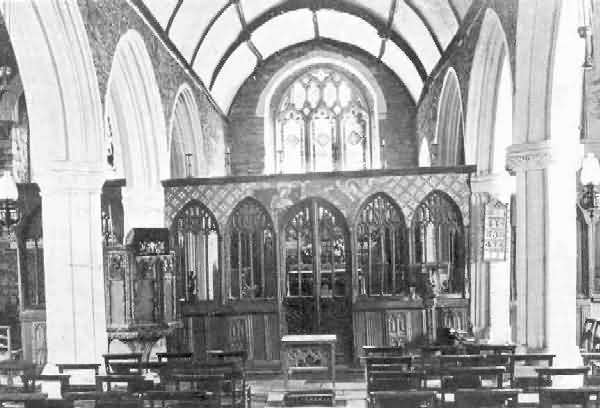
Cockington: Rood Screen
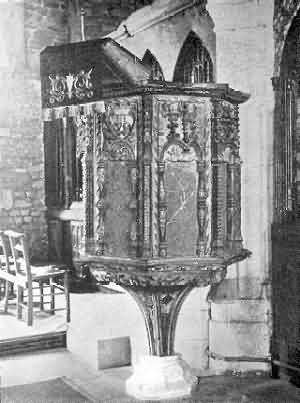
Cockington: Pulpit
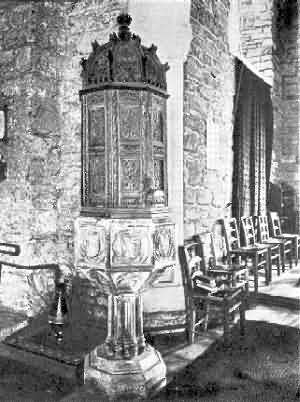
Cockington: Font
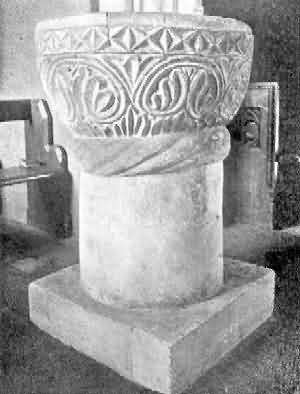
Coffinswell: Font
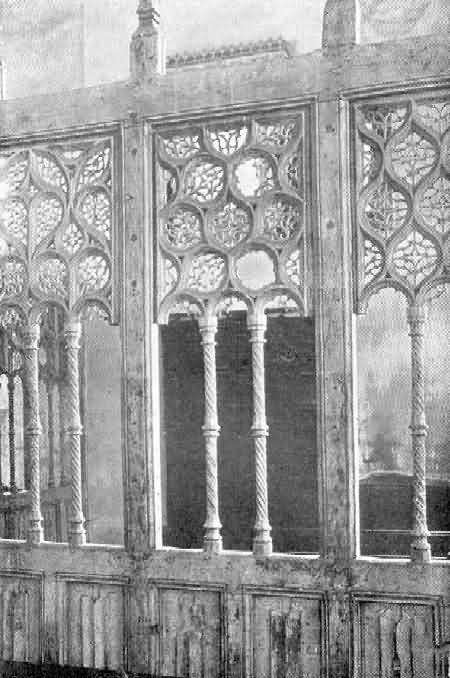
Colebrook: Parclose Screen
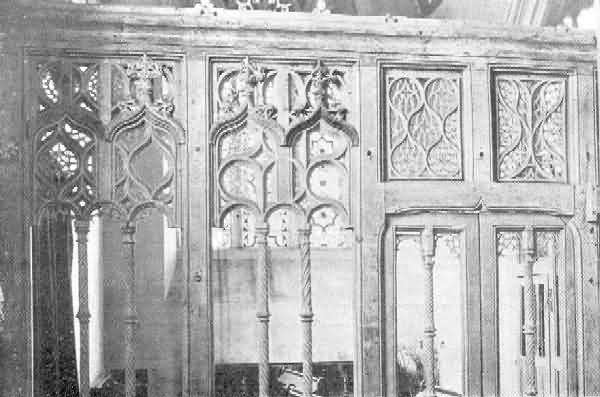
Colebrook: North Aisle Screen
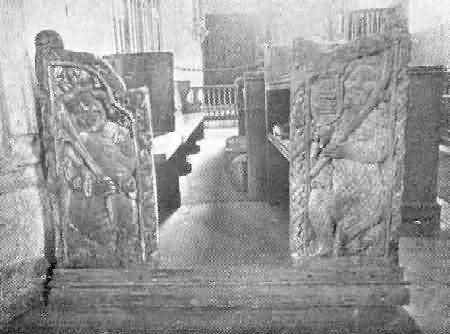
Colebrook: Old Prie-Dieu
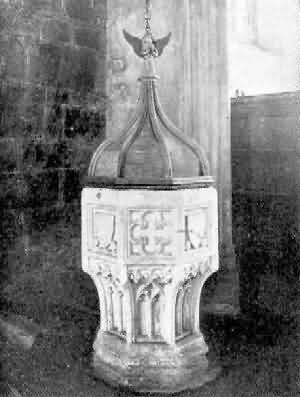
Colebrook: Font
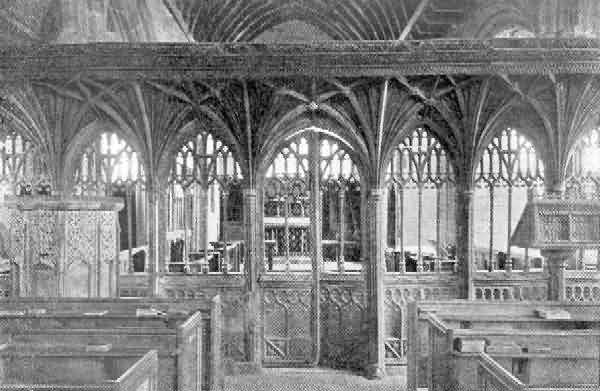
Coleridge: Rood Screen
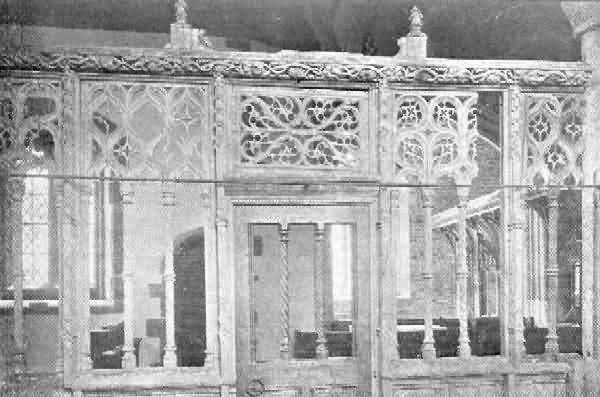
Coleridge: North Parclose Screen
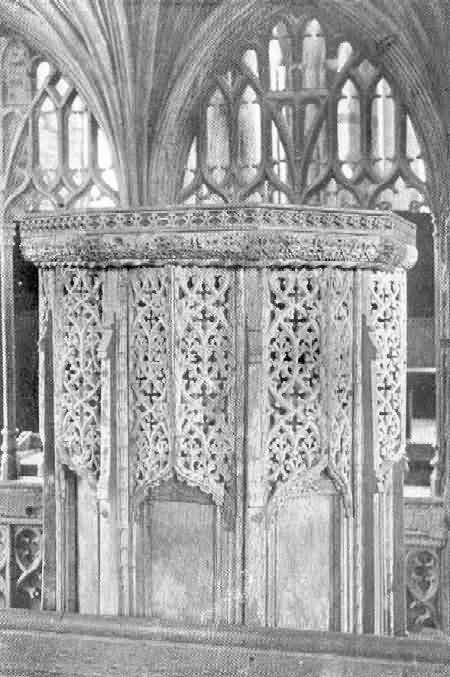
Coleridge: Pulpit
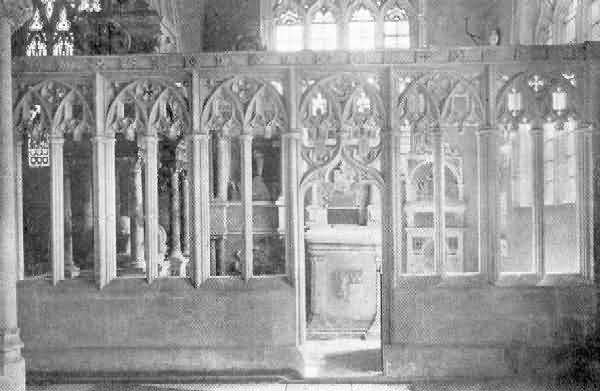
Colyton: South Chapel Screen
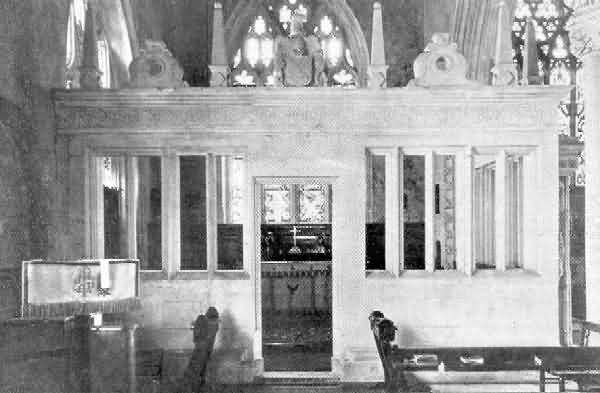
Colyton: North Chapel Screen
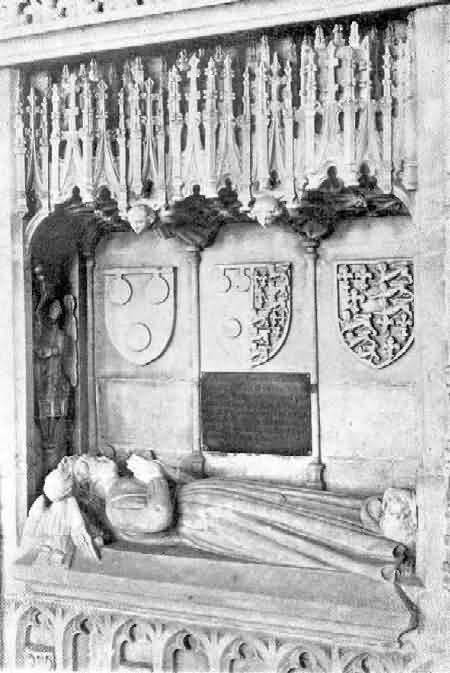
Colyton: Courtenay Monument
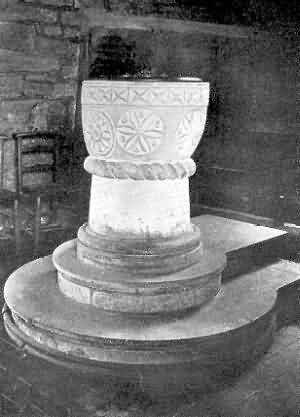
Combe-in-Teignhead: Font
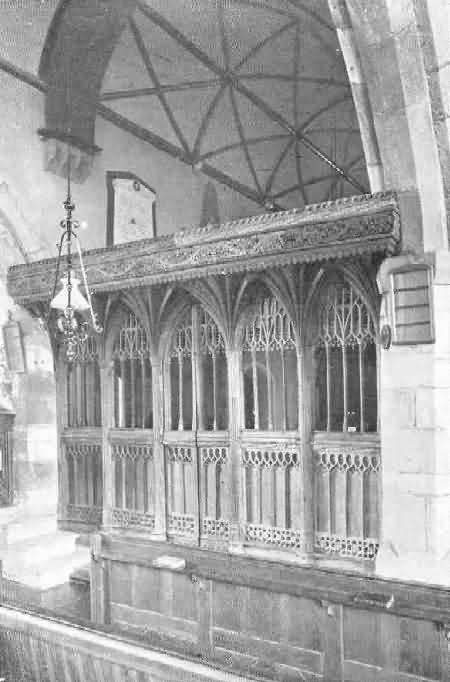
Combe-in-Teignhead: Rood Screen
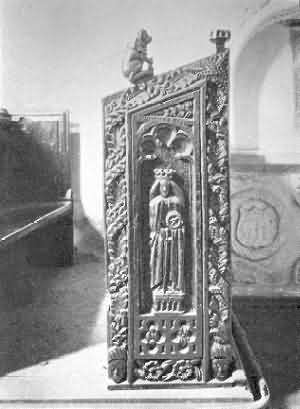
Combe-in-Teignhead: St. Catherine Bench-End
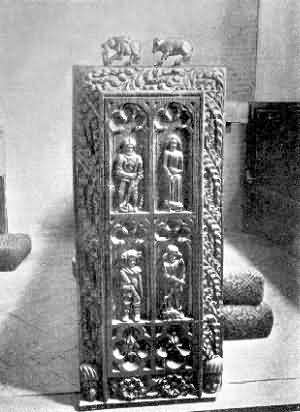
Combe-in-Teignhead: St. Genes Bench-End
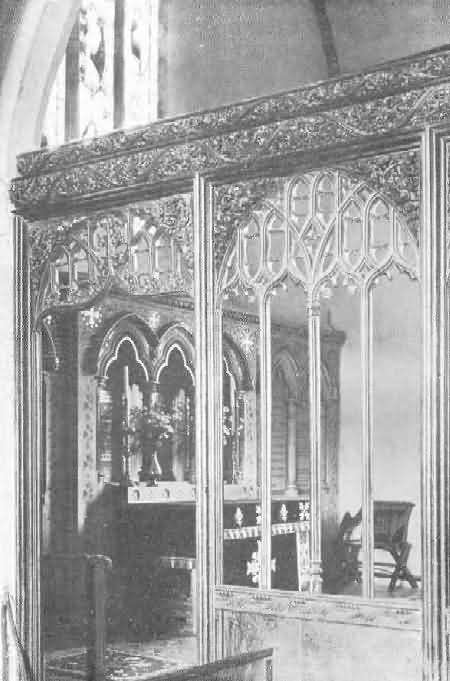
Combe Martin: Parclose Screen
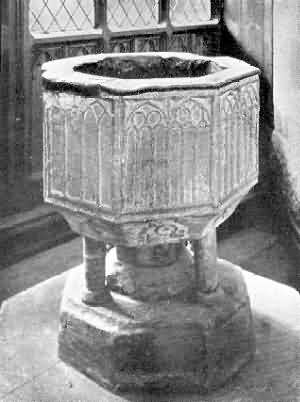
Combe Martin: Font
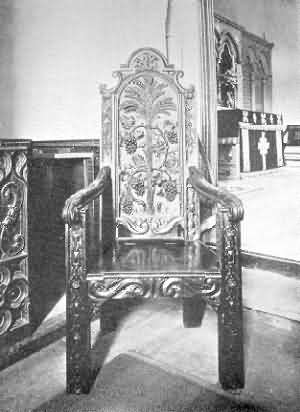
Combe Martin: Bishop's Chair
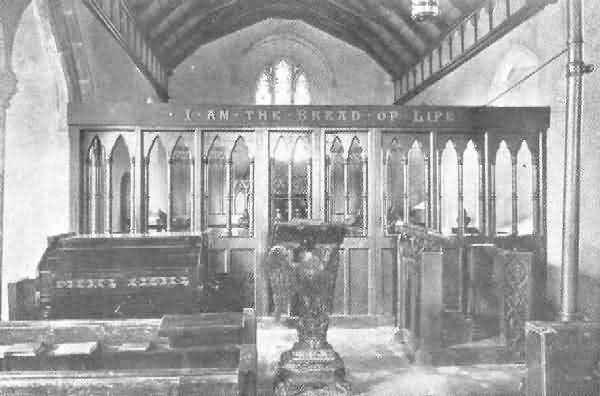
Cookbury: Interior
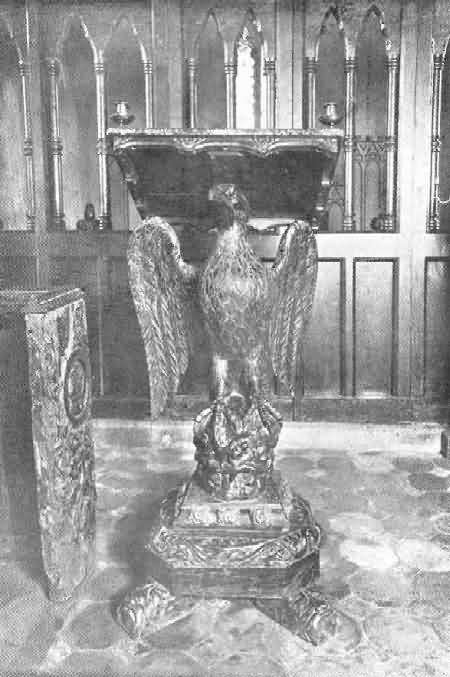
Cookbury: Eagle Lectern
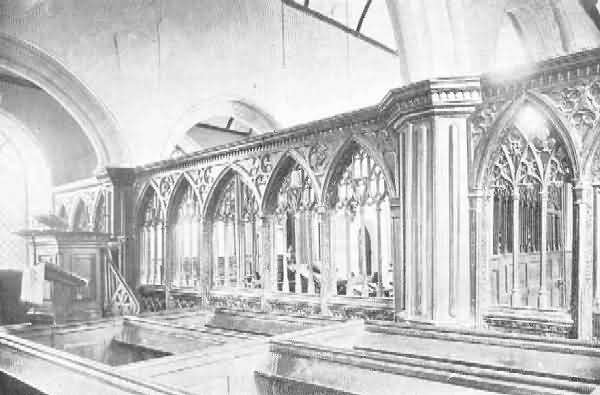
Cornworthy: Rood Screen
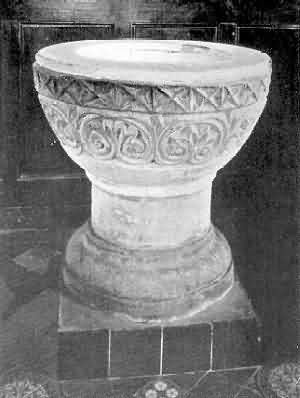
Cornworthy: Font
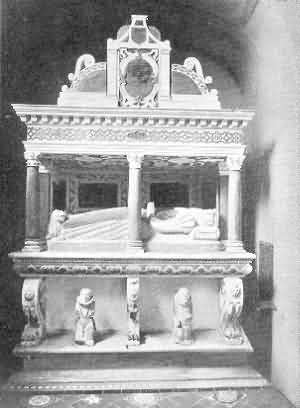
Cornworthy: Harris Monument
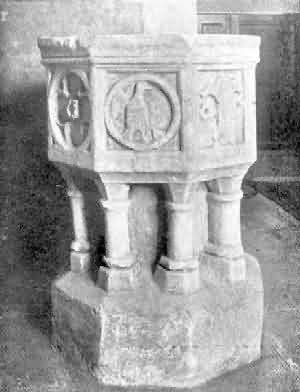
Cotleigh: Font
«Some Old Devon Churches»:
Index; 73-84
[Dr. R. Peters: rpeters@wissensdrang.com]